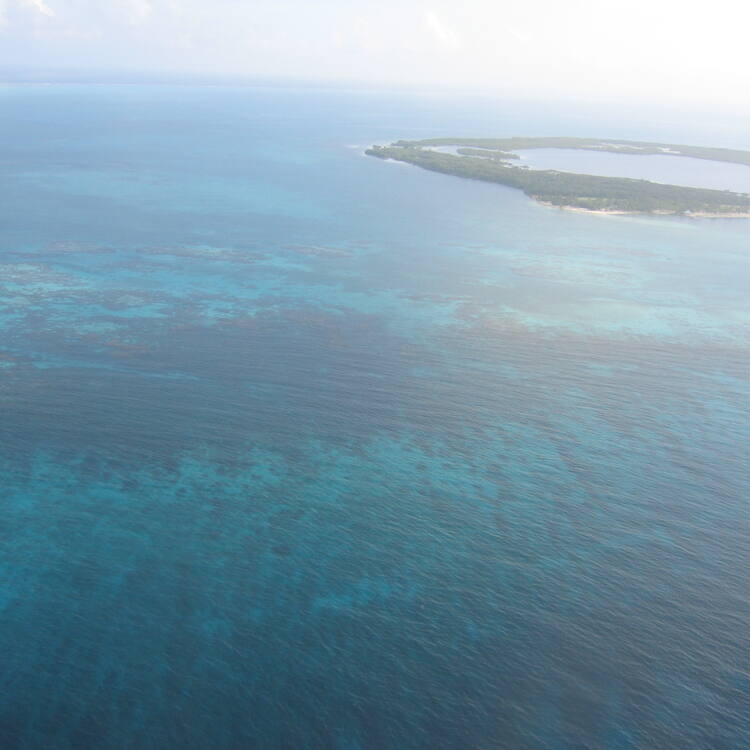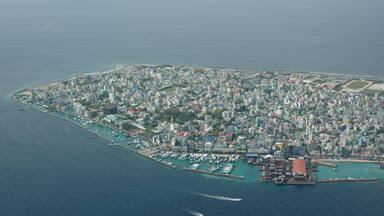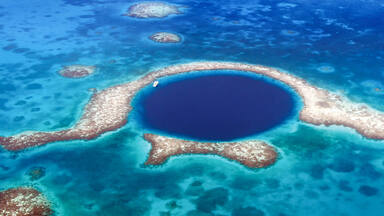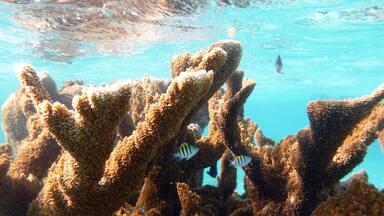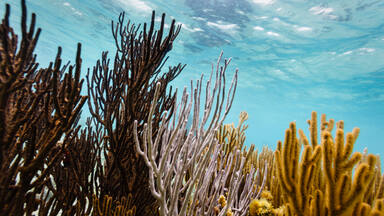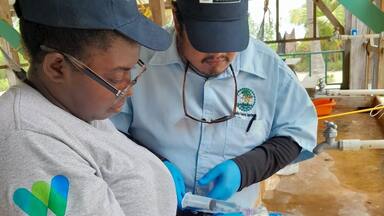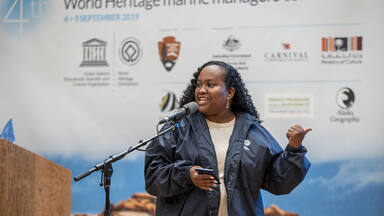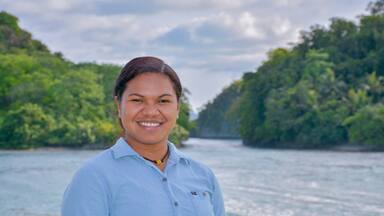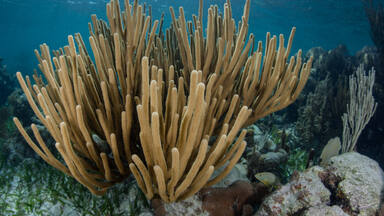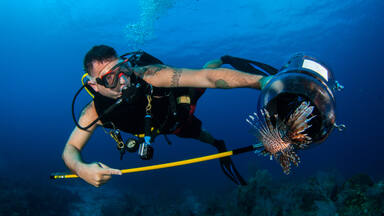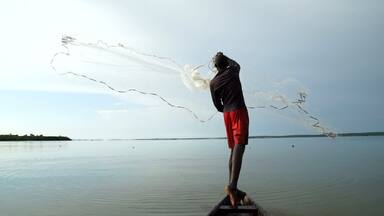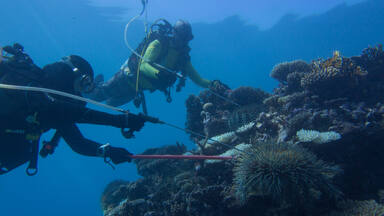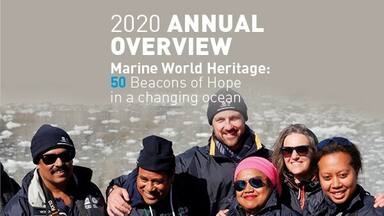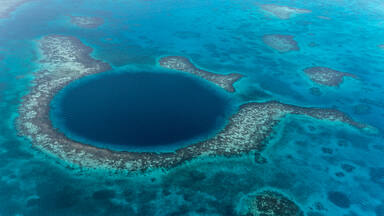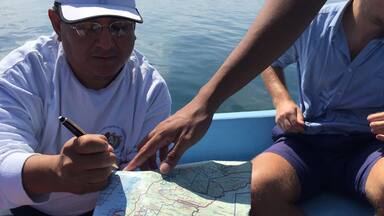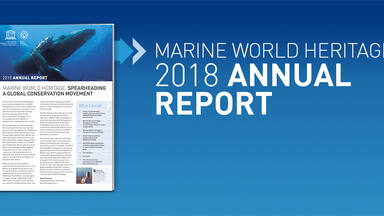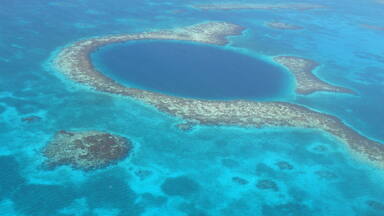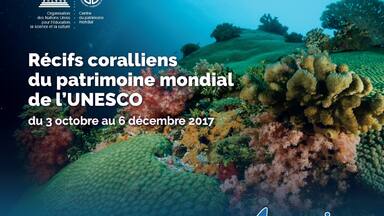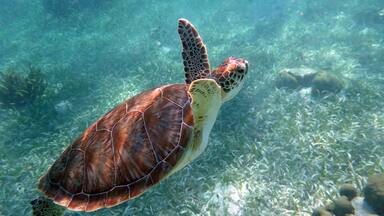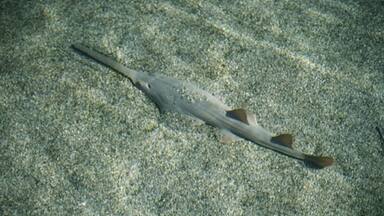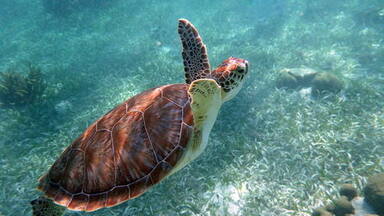Belize Barrier Reef Reserve System
Belize Barrier Reef Reserve System
The coastal area of Belize is an outstanding natural system consisting of the largest barrier reef in the northern hemisphere, offshore atolls, several hundred sand cays, mangrove forests, coastal lagoons and estuaries. The system’s seven sites illustrate the evolutionary history of reef development and are a significant habitat for threatened species, including marine turtles, manatees and the American marine crocodile.
Description is available under license CC-BY-SA IGO 3.0
Réseau de réserves du récif de la barrière du Belize
La région côtière du Belize est un système naturel exceptionnel qui comprend le plus grand récif-barrière de l’hémisphère Nord, des atolls bordiers, plusieurs centaines de cayes de sable, des forêts de mangroves, des lagons côtiers et des estuaires. Les sept sites du réseau illustrent les étapes de l’évolution des récifs et constituent un habitat important pour des espèces menacées telles que les tortues marines, les lamantins et le crocodile marin d’Amérique.
Description is available under license CC-BY-SA IGO 3.0
نظام محميات الحاجز المرجاني في بليز
تشكّل منطقة بليز الساحلية نظاماً طبيعياً استثنائياً يحتوي على أكبر حاجز مرجاني في النصف الشمالي للكرة الأرضية، وعلى جزر مرجانية متاخمة، ومئات الجزر الرملية المنخفضة، وغابات المنغروف، والبحيرات المرجانية الساحلية ومصابّ الأنهر. تجسّد المواقع السبعة لهذا النظام مراحل التطور الذي شهدته الشُعب كما تؤمّن ملاذاً آمناً لأجناس مهددة بالإنقراض كالسلاحف البحرية، وخراف البحر، والتمساح البحري الأميركي.
source: UNESCO/CPE
Description is available under license CC-BY-SA IGO 3.0
伯利兹堡礁保护区
伯利兹海岸是一处风景绝佳的自然生态系统,由北半球最大的堡礁、近海环礁、几百个沙洲、美洲红树林、沿海泻湖、港湾组成。保护区内的七处景点展示了暗礁进化的历史,是包括海龟、海牛和美洲湾鳄在内的濒危物种的重要栖息地。
source: UNESCO/CPE
Description is available under license CC-BY-SA IGO 3.0
Резерваты Барьерного Рифа Белиза
Прибрежная зона Белиза – это ценнейшая экосистема, включающая самый крупный барьерный риф Северного полушария, а также атоллы, несколько сотен песчаных островков, мангровые заросли, лагуны и речные эстуарии. Семь участков данного объекта наследия иллюстрируют эволюционное развитие рифов. Здесь встречается целый ряд редких видов, к примеру, морские черепахи, ламантин и американский острорылый крокодил.
source: UNESCO/CPE
Description is available under license CC-BY-SA IGO 3.0
Red de reservas del arrecife de barrera de Belice
La región costera de Belice es un sistema natural único en su género, que comprende el mayor arrecife de barrera del hemisferio norte, atolones costeros, centenares de cayos arenosos, bosques de mangles, lagunas litorales y estuarios. Las siete reservas de la red ilustran las diferentes etapas de evolución del arrecife y son un hí¡bitat importante para algunas especies animales en peligro como las tortugas marinas, los manatíes y el cocodrilo marino de América.
source: UNESCO/CPE
Description is available under license CC-BY-SA IGO 3.0
ベリーズのバリア・リーフ保護区
source: NFUAJ
Barrièrerif reservaat van Belize
Source: unesco.nl
Outstanding Universal Value
Brief synthesis
The Belize Barrier Reef Reserve System (BBRRS), inscribed as a UNESCO World Heritage Site in 1996, is comprised of seven protected areas; Bacalar Chico National Park and Marine Reserve, Blue Hole Natural Monument, Half Moon Caye Natural Monument, South Water Caye Marine Reserve, Glover’s Reef Marine Reserve, Laughing Bird Caye National Park and Sapodilla Cayes Marine Reserve. The largest reef complex in the Atlantic-Caribbean region it represents the second largest reef system in the world. The seven protected areas that constitute the BBRRS comprise 12% of the entire Reef Complex.
The unique array of reef types within one self-contained area distinguishes the BBRRS from other reef systems. The site is one of the most pristine reef ecosystems in the Western Hemisphere and was referred to ‘as the most remarkable reef in the West Indies’ by Charles Darwin. Outside of the reef complex the property contains three atolls; Turneffe Island, Lighthouse Reef and Glover’s Reef. The Barrier Reef and atolls exhibit some of the best reef growth in the Caribbean. The reef complex is comprised of approximately 450 sand and mangrove cayes.
The property provides important habitat for a number of threatened marine species, harbouring a number of species of conservation concern including the West Indian manatee (Trichechus manatus), green turtle (Chelonia mydas), hawksbill turtle (Eretmochelys imbricata), loggerhead turtle (Caretta caretta), and the American crocodile (Crocodylus acutus) as well as endemic and migratory birds which reproduce in the littoral forests of cayes, atolls and coastal areas. Major bird colonies include the red-footed booby (Sula sula) on Half-Moon Caye, brown booby (Sula leucogaster) on Man O’War Caye and the common noddy (Anous stolidus) on Glover’s Reef. Approximately 247 taxa of marine flora have been described within the complex and over 500 fish, 65 sceleritian coral, 45 hydroid and 350 mollusc species have also been identified, in addition to a great diversity of sponges, marine worms and crustaceans.
Criterion (vii): The Belize Barrier Reef Reserve System (BBRRS) is unique in the world for its array of reef types contained in a relatively small area. As the longest barrier reef in the Northern and Western Hemispheres and distinctive on account of its size, array of reef types and the luxuriance of corals thriving in a pristine condition it provides a classic example of the evolutionary history of reefs and reef systems. The rise and fall of sea level over the millennia, coupled with natural karst topography and clear waters, results in a diverse submarine seascape of patch reefs, fringing reefs, faros, pinnacle reefs, barrier reefs as well as off-shelf atolls, rare deep water coral reefs and other unique geological features such as the Blue Hole and Rocky Point where the barrier reef touches the shore. The spectacular picturesque natural setting of brilliant white sand cayes and verdant green mangrove cayes is in dramatic contrast to the surrounding azure waters.
Criteria (ix): Illustrating a classic example of reef types, including fringing, barrier and atoll reef types, the BBRRS contains an intact ecosystem gradient ranging from the terrestrial to the deep ocean. Including littoral, wetland, and mangrove ecosystems, to seagrass beds interspersed with lagoonal reefs, to the outer barrier reef platform and oceanic atolls, this ecological gradient provides for a full complement of life-cycle needs, supporting critical spawning, nesting, foraging, and nursery ecosystem functions. Maintaining these ecological and biological processes ensures robust and resilient reefs, which are them selves one of the world’s most ancient and diverse ecosystems.
Criteria (x): Home to a diverse array of top predators, on land, sea and in the air, the jaguars of Bacalar Chico, the great hammerheads of the Blue Hole, and the ospreys of Glovers Reef are a testament to the property’s importance and its ecological integrity. A total of 178 terrestrial plants and 246 taxa of marine flora have been described from the area while over 500 species of fish, 65 scleractinian corals, 45 hydroids and 350 molluscs have been recorded. Numerous endangered species are protected within the boundaries of the BBRRS including; the West Indian manatee, the American crocodile and three species of sea turtle. The property also provides valuable habitat for three species of groupers, and the red-footed booby. The BBRRS is also home to endemic species including several Yucatan birds, island lizards, several fishes, tunicates, and sponges, making it an area with one of the highest levels of marine biodiversity in the Atlantic.
Integrity
The Belize Barrier Reef Reserve System is one interconnected system comprised of seven marine protected areas located along the length of the barrier reef, the shelf lagoon and offshore atolls. It is the largest barrier reef in the Northern hemisphere and represents all the main reef and coastal habitats, including rare littoral forest on sand cayes that are home to endangered flora and fauna. The network of protected areas is large enough to maintain the necessary ecological processes and support the BBRRS for the long term. Its geographic spread and diversity enhance its resilience, an essential factor in this time of climate change with its risks of coral bleaching, stronger and more frequent hurricanes and sea level rise.
Management challenges and threats that impact on the integrity of the property include; overharvesting of marine resources, coastal development, tourism, industrial development and proposed oil and gas exploration and exploitation. These threats, common to marine protected areas in general are less intense due to relatively low population pressure, however, careful management is required to ensure growing population pressures do not lead to significant impacts on the integrity of the property.
Protection and management requirements
Extending from the border with Mexico to the north, to near the Guatemalan border to the south the geographical spread of this serial property poses a number of management challenges. The component sites of the serial property have been gazetted as protected areas with legal protection measures provided under the national constitution, the Fisheries Act and the National Parks Act. Oversight of all protected areas, including the BBRRS, is governed through various pieces of legislation administered by various Government of Belize Departments spread across various Ministries.
The National Protected Areas Policy is Belize’s policy on protected areas and provides the overarching policy framework, whereas the National Protected Areas System Plan details inter alia specific requirements for protected areas resource management, planning and management effectiveness evaluations. In addition to entrance fees, financial support for all protected areas in Belize can be accessed through the national Protected Areas Conservation Trust. Those sites and co-managers that constitute the BBRRS can also access funds under the Community Management of Protected Areas for Conservation (COMPACT) and other international funding sources.
Government authorities have approached the management challenges posed by the size and nature of the property strategically, establishing innovative co-management agreements with various non-governmental organizations. This helps to ensure successful on-the-ground supervision, backed up by national legislation and guided by official management plans that are available for each of the component protected areas and include resource protection, research and monitoring, surveillance and enforcement, community outreach and education, and financial sustainability. However, the complexities of managing a number of protected areas spread over a considerable area requires detailed institutional coordination mechanisms to ensure the protection of the property and its Outstanding Universal Value.
Coordination amongst government agencies responsible for coastal development, including activities such as mangrove clearance and dredging, is required for conservation and effective management of the property. Revitalization of the Coastal Zone Management Authority and Institute (CZMAI), will strengthen this crucial element of integrated coastal management, particularly through the completion and legal adoption of the Coastal Zone Management Plan. Implementation of this Plan will assist with control, regulation, mitigation and minimizing threats such as uncontrolled development, unsustainable tourism and fishing, and declining water quality. Belize's long history of marine species conservation, trans-boundary coastal management cooperation, and involvement in several regional conservation initiatives is based on a recognition of the fact that the seas and resident wildlife are not confined to protected areas or within political boundaries, further enhances the conservation of the BBRRS WHS.
Strengthening of mangrove regulations, the fisheries and marine reserve regulations, and the Environment Impact Assessment process will lead to more sustainable use of resources both within the BBRRS and the surrounding areas. Policy development and contingency planning are required for impacts of possible oil and gas exploration located outside the property, impacts from tourism and to address climate change concerns. Along with these regulatory and policy improvements, strengthened enforcement will also assist in management and long-term protection of the property. Added protection and management measures, and the ongoing dedication and coordinated work of government and non-government organizations, will ensure the outstanding values of the BBRRS will remain intact.
